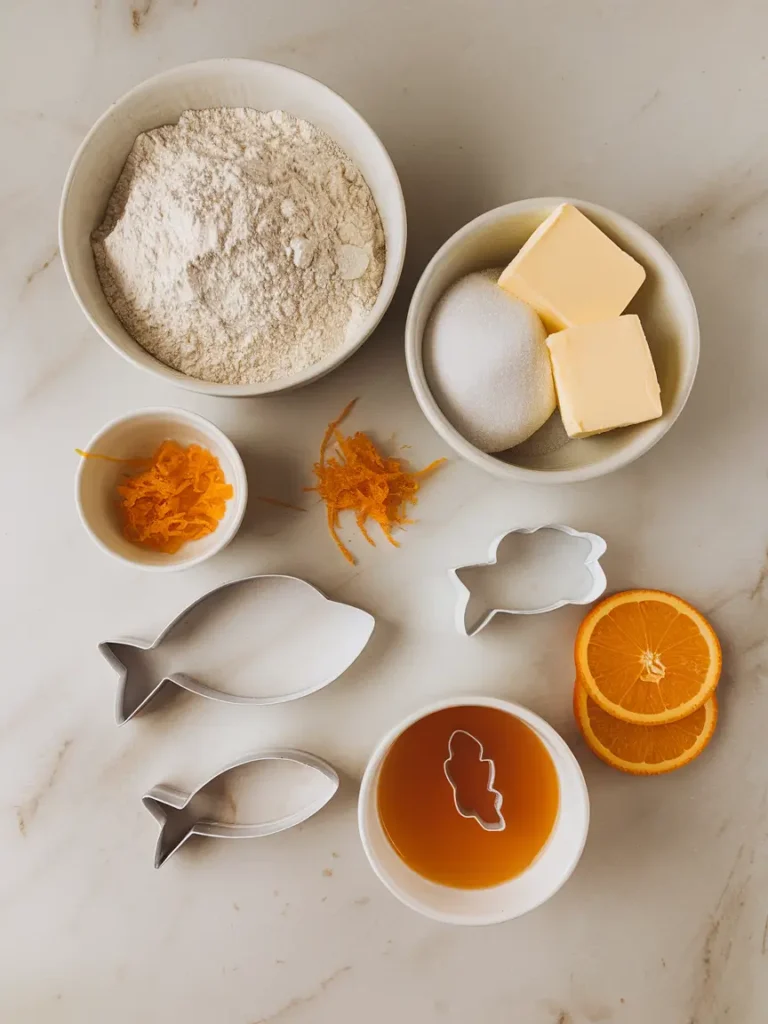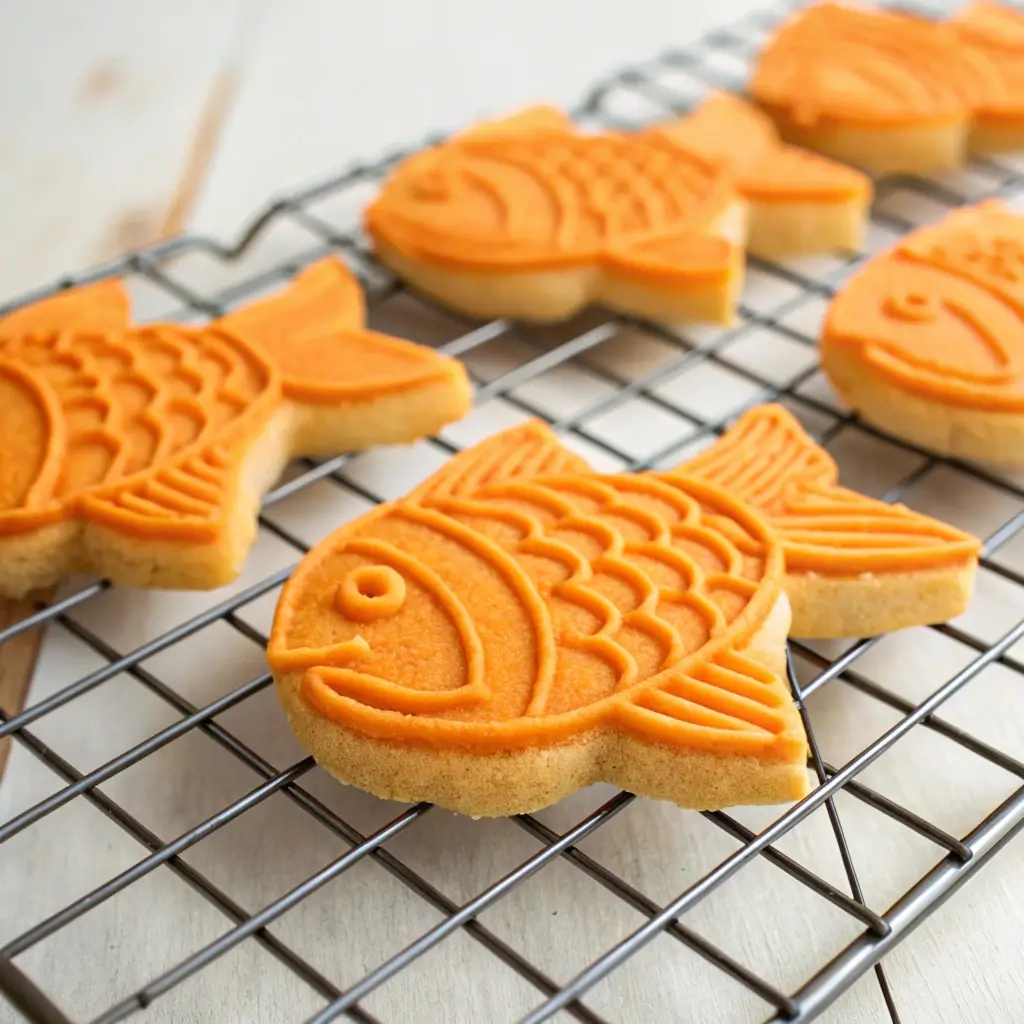Orange Fish Cookies Recipe: A Fun and Citrusy Delight
Table of Contents
Looking to add a splash of creativity and flavor to your cookie baking routine? This article dives into the delightful world of Orange Fish Cookies! These cookies are a whimsical twist on classic citrus-flavored treats, shaped like adorable fish and bursting with the tangy freshness of oranges. Whether you’re planning a themed party, a fun baking activity with kids, or simply exploring new recipes, these cookies promise to be both visually stunning and delicious.
In this article, we’ll walk you through every step of the process — from gathering the right ingredients to perfecting your decorating skills. You’ll also find helpful tips, creative variations, and answers to common questions. Let’s get started!
Introduction to Orange Fish Cookies
What Are Orange Fish Cookies?
Orange Fish Cookies are a playful and flavorful twist on traditional cookies. They’re made using a simple orange-flavored dough and shaped to resemble little fish, making them a hit with kids and adults alike. The tangy zest of fresh oranges pairs perfectly with the sweetness of the cookie, offering a taste that’s as delightful as the design.
These cookies aren’t just for snacking; they’re great for themed events, birthday parties, or even as thoughtful homemade gifts. Their unique appearance sets them apart, while the refreshing citrus flavor keeps everyone coming back for more.
The Appeal of Citrus-Flavored Cookies
Why choose citrus cookies over classic chocolate chip or sugar cookies? Citrus-infused treats bring a zesty brightness that balances sweetness with a touch of tartness. The inclusion of orange zest and juice elevates the flavor profile, making these cookies light and refreshing.
Moreover, orange is a versatile ingredient that complements various add-ins like chocolate chips, dried cranberries, or even nuts. The result? A cookie that’s as versatile as it is delicious.
Occasions to Serve Orange Fish Cookies
These charming cookies shine on a variety of occasions:
- Themed Parties: Perfect for underwater or beach-themed gatherings.
- Holiday Celebrations: Add a citrusy touch to holiday cookie platters.
- Kid-Friendly Baking Projects: Fun shapes make these cookies a hit with little bakers.
- Gifting: Pack them in decorative boxes for a thoughtful, homemade gift.
Orange Fish Cookies combine flavor, fun, and creativity into one delightful dessert. Now that you know why they’re so special, let’s dive into the ingredients you’ll need to create them!
Ingredients Needed for Orange Fish Cookies

Essential Ingredients for the Dough
To create the delightful Orange Fish Cookies Recipe, gather the following ingredients:
- 2 ½ cups all-purpose flour: Provides the structure for your cookies.
- 1 cup unsalted butter, softened: Adds richness and flavor.
- 1 cup granulated sugar: Sweetens the dough.
- 1 large egg: Binds the ingredients together.
- 2 tablespoons fresh orange juice: Infuses a natural citrus flavor.
- 1 tablespoon orange zest: Enhances the orange aroma and taste.
- 1 teaspoon baking powder: Helps the cookies rise slightly.
- ½ teaspoon salt: Balances the sweetness.
- 1 teaspoon vanilla extract: Adds depth to the flavor profile.
These components combine to form a dough that’s both easy to work with and bursting with citrus goodness.
Optional Add-ins for Enhanced Flavor
To elevate your Orange Fish Cookies Recipe, consider incorporating:
- Mini chocolate chips: For a touch of indulgence.
- Dried cranberries: Introduce a tart contrast.
- Chopped nuts: Add a satisfying crunch.
These additions can be mixed into the dough before shaping, allowing you to customize the cookies to your liking.
Tools and Equipment Required
Ensure you have the following tools on hand:
- Mixing bowls: For combining ingredients.
- Electric mixer: To cream butter and sugar efficiently.
- Fish-shaped cookie cutters: Essential for achieving the signature look.
- Baking sheets: To bake the cookies evenly.
- Parchment paper: Prevents sticking and aids in easy cleanup.
- Cooling rack: Allows cookies to cool properly, maintaining their texture.
Having these tools ready will streamline the baking process, making it both enjoyable and efficient.
Step-by-Step Preparation Guide
Preparing the Dough
- Cream the Butter and Sugar: In a large mixing bowl, use an electric mixer to beat 1 cup of softened unsalted butter and 1 cup of granulated sugar until the mixture is light and fluffy. This process incorporates air, resulting in a tender cookie texture.
- Add Wet Ingredients: Beat in 1 large egg, 2 tablespoons of fresh orange juice, 1 tablespoon of orange zest, and 1 teaspoon of vanilla extract. The combination of orange juice and zest imparts a vibrant citrus flavor, essential for the Orange Fish Cookies Recipe.
- Combine Dry Ingredients: In a separate bowl, whisk together 2 ½ cups of all-purpose flour, 1 teaspoon of baking powder, and ½ teaspoon of salt. Gradually add this dry mixture to the wet ingredients, mixing until a cohesive dough forms. If desired, fold in optional add-ins like mini chocolate chips or dried cranberries at this stage.
- Chill the Dough: Shape the dough into a disc, wrap it in plastic wrap, and refrigerate for at least 1 hour. Chilling firms up the dough, making it easier to roll out and cut into shapes.
Shaping the Fish Cookies
- Preheat the Oven: Set the oven to 350°F (175°C) to ensure it’s adequately heated when you’re ready to bake.
- Roll Out the Dough: On a lightly floured surface, roll the chilled dough to a ¼-inch thickness. Maintaining an even thickness ensures uniform baking.
- Cut Out Fish Shapes: Using fish-shaped cookie cutters, cut out cookies and place them on baking sheets lined with parchment paper. Leave about 1 inch of space between each cookie to allow for slight spreading.
Baking Instructions
- Bake the Cookies: Place the baking sheets in the preheated oven and bake for 10-12 minutes, or until the edges are lightly golden. Keep a close eye to prevent overbaking, as this can lead to a dry texture.
- Cool the Cookies: Remove the cookies from the oven and allow them to cool on the baking sheet for 5 minutes. Then, transfer them to a cooling rack to cool completely before decorating. This step prevents the icing from melting upon application.
Cooling and Storage Tips
- Cooling: Ensure cookies are completely cool before decorating to prevent icing from running.
- Storage: Store undecorated cookies in an airtight container at room temperature for up to a week. If decorated, place parchment paper between layers to protect the designs.
- Freezing: Both the dough and baked cookies can be frozen. For the dough, wrap it tightly in plastic wrap and freeze for up to 3 months. Thaw in the refrigerator before use. For baked cookies, place them in a single layer on a baking sheet to freeze, then transfer to a freezer-safe container, separating layers with parchment paper. Thaw at room temperature before decorating or serving.
Decorating Your Orange Fish Cookies

Choosing the Right Icing
Decorating your Orange Fish Cookies adds a personal touch and makes them truly stand out. To begin, selecting the appropriate icing is crucial. Royal icing is a popular choice due to its smooth finish and ability to harden, making it ideal for detailed designs. To prepare royal icing, you’ll need:
- 2 cups powdered sugar: Provides sweetness and structure.
- 1 ½ tablespoons meringue powder: Helps the icing set firmly.
- 3-4 tablespoons water: Adjusts the consistency.
- Food coloring: To achieve vibrant hues for your fish designs.
Mix the powdered sugar and meringue powder, then gradually add water until you reach a thick yet pipeable consistency. Divide the icing into separate bowls and add food coloring as desired.
Creative Decorating Ideas
Once your icing is ready, it’s time to let your creativity shine. Here are some fun ideas to decorate your Orange Fish Cookies:
- Colorful Scales: Use different shades of icing to create a gradient effect on the fish scales. Start with a base color and layer additional colors on top, allowing each layer to dry slightly before adding the next.
- Edible Glitter: Add a touch of sparkle by sprinkling edible glitter over the icing while it’s still wet. This gives your fish a shimmering, underwater appearance.
- Candy Eyes: Attach small candy eyes to bring your fish cookies to life. Alternatively, you can use a dot of black icing to create eyes.
- Piping Details: Use a fine-tipped piping bag to add intricate details like fins, mouths, and gills. This adds depth and character to your cookies.
Remember to allow each layer of icing to dry before adding additional details to prevent colors from bleeding.
Involving Kids in the Decoration Process
Decorating Orange Fish Cookies is a fantastic activity to enjoy with children. To make the experience enjoyable and stress-free:
- Set Up a Decorating Station: Prepare a workspace with various icing colors, sprinkles, and decorating tools. Lay down parchment paper to catch any spills and make cleanup easier.
- Demonstrate Techniques: Show kids how to hold the piping bags and apply gentle pressure to control the flow of icing. Encourage them to practice on a piece of parchment paper before decorating the cookies.
- Encourage Creativity: Allow children to express their creativity without worrying about perfection. Praise their efforts and enjoy the unique designs they create.
- Supervise and Assist: Be on hand to help with any challenges, such as refilling icing bags or fixing minor mistakes. Ensure that all decorating materials used are safe and edible.
By involving kids in the decorating process, you create lasting memories and instill a love for baking and creativity.
For more delicious recipes, check out our recipe article.

Variations and Substitutions
Alternative Citrus Flavors
While the classic Orange Fish Cookies Recipe is delightful, experimenting with other citrus flavors can add a refreshing twist. Consider these alternatives:
- Lemon Fish Cookies: Substitute orange juice and zest with lemon juice and zest for a tangier flavor. The bright lemon taste pairs well with a light glaze or poppy seeds.
- Lime Fish Cookies: Replace orange components with lime juice and zest to achieve a zesty, tropical flavor. Lime pairs wonderfully with coconut flakes incorporated into the dough or used as a garnish.
- Grapefruit Fish Cookies: For a unique and slightly bitter citrus profile, use grapefruit juice and zest. Balance the bitterness with a sweet honey glaze or white chocolate drizzle.
These variations allow you to customize the recipe to your taste preferences and explore new flavor combinations.
Gluten-Free and Vegan Options
To accommodate dietary restrictions, consider these substitutions:
- Gluten-Free: Replace all-purpose flour with a gluten-free flour blend that includes xanthan gum to mimic the elasticity of gluten. Ensure all other ingredients, like baking powder, are certified gluten-free.
- Vegan: Substitute butter with plant-based margarine or coconut oil, and replace the egg with a flaxseed or chia seed egg (1 tablespoon ground flaxseed or chia seeds mixed with 3 tablespoons water, allowed to sit until gelled). Use aquafaba (the liquid from canned chickpeas) as an alternative to meringue powder in the icing.
These adjustments make the Orange Fish Cookies Recipe accessible to those with gluten sensitivities or following a vegan diet.
Incorporating Nuts or Dried Fruits
Enhance the texture and flavor of your cookies by adding:
- Chopped Nuts: Fold in finely chopped almonds, pecans, or pistachios to add a satisfying crunch. Toasting the nuts beforehand intensifies their flavor.
- Dried Fruits: Include small pieces of dried cranberries, apricots, or raisins for a chewy texture and natural sweetness. Ensure the dried fruits are soft and plump; if not, soak them in warm water for a few minutes and drain before adding to the dough.
When adding mix-ins, be mindful of the dough’s consistency. If it becomes too dry, incorporate a small amount of additional citrus juice to maintain the desired texture. These additions can elevate your Orange Fish Cookies and introduce delightful new flavors and textures.
Tips for Perfect Orange Fish Cookies
Common Mistakes to Avoid
Even with the best Orange Fish Cookies Recipe, small missteps can affect the final outcome. To ensure perfect cookies every time, steer clear of these common mistakes:
- Skipping the Dough Chilling Step: Chilling the dough is crucial for maintaining the fish shape while baking. Without it, the cookies may spread too much.
- Overmixing the Dough: Mixing the dough too long after adding the flour can lead to tough cookies. Mix until just combined.
- Using Too Much Flour: Always measure flour accurately using the spoon-and-level method. Excess flour can make the cookies dry and crumbly.
- Overbaking: Keep a close eye on the baking time. Pull the cookies out as soon as the edges turn golden for a soft, tender texture.
Achieving the Ideal Texture
The perfect Orange Fish Cookies should strike a balance between being soft enough to melt in your mouth and sturdy enough to hold their shape. Here are some tips:
- Use Room-Temperature Ingredients: Softened butter and room-temperature eggs blend more evenly, creating a smoother dough.
- Roll the Dough Evenly: An even thickness ensures consistent baking, avoiding overcooked edges or undercooked centers.
- Check Consistency: The dough should be pliable but not sticky. If it feels too sticky, add a tablespoon of flour at a time until it’s easier to work with.
Storage and Shelf-Life Recommendations
To keep your cookies fresh:
- Room Temperature: Store baked cookies in an airtight container at room temperature for up to a week. Separate layers with parchment paper to prevent sticking.
- Freezing: Freeze baked cookies for up to 3 months. Thaw at room temperature before serving.
- Refrigerating Dough: Dough can be refrigerated for up to 2 days or frozen for up to 3 months. Thaw overnight in the fridge before rolling and cutting.
Serving Suggestions and Pairings
Beverage Pairings
The bright, zesty flavor of Orange Fish Cookies pairs wonderfully with a variety of beverages. Here are a few suggestions:
- Hot Drinks: Serve with a steaming cup of herbal tea, like chamomile or mint, to complement the citrus notes. For coffee lovers, a creamy latte balances the tanginess.
- Cold Beverages: Pair with a refreshing glass of iced tea or sparkling water infused with orange slices. These light, citrusy drinks enhance the cookies’ flavor without overwhelming it.
- Milk Options: A classic pairing, a cold glass of milk (dairy or plant-based) is a great choice, especially for kids.
Presentation Ideas for Parties
Make your Orange Fish Cookies Recipe the centerpiece of any event with these creative serving ideas:
- Underwater-Themed Platters: Arrange the cookies on a blue plate or tray lined with edible “sand” made of crushed graham crackers. Add candy seashells for an extra touch.
- Gift Packaging: Place cookies in clear cellophane bags tied with a ribbon. Attach a cute tag featuring the recipe or a thank-you note.
- Cookie Towers: Stack the cookies on a tiered dessert stand for an elegant presentation at parties or special events.
Packaging for Gifting
Homemade cookies make thoughtful gifts. Package your Orange Fish Cookies in decorative tins or boxes lined with parchment paper. For a festive touch, add a personalized label or a small card with a fun message.
By pairing and presenting your cookies thoughtfully, you can elevate this simple treat into something truly special.
Frequently Asked Questions
Can I Use Bottled Orange Juice Instead of Fresh?
Yes, bottled orange juice can be a substitute in the Orange Fish Cookies Recipe. However, fresh orange juice is highly recommended for its vibrant and natural flavor. Freshly squeezed juice also contains less sugar and preservatives, making it a healthier and tastier option. If using bottled juice, choose one that’s 100% pure orange juice for the best results.
How Do I Prevent the Cookies from Spreading Too Much?
To keep your cookies from spreading during baking, make sure to chill the dough thoroughly before rolling and cutting. This step firms up the butter, which prevents the cookies from losing their shape. Additionally, avoid over-creaming the butter and sugar, as excessive air in the dough can cause spreading.
What’s the Best Way to Store These Cookies?
Store your baked Orange Fish Cookies in an airtight container at room temperature for up to a week. If you’ve decorated them, layer parchment paper between cookies to preserve the designs. For longer storage, freeze the cookies in a single layer before transferring them to a freezer-safe container.
Can I Freeze the Dough for Later Use?
Absolutely! The cookie dough can be wrapped tightly in plastic wrap and stored in the freezer for up to three months. Thaw the dough in the refrigerator overnight before rolling, cutting, and baking.
Orange Fish Cookies
Equipment
- Mixing Bowls
- Electric Mixer
- Fish-Shaped Cookie Cutters
- Baking Sheets
- Parchment Paper
- Cooling Rack
Ingredients
Cookie Dough
- 2 1/2 cups all-purpose flour
- 1 cup unsalted butter softened
- 1 cup granulated sugar
- 1 large egg
- 2 tbsp fresh orange juice
- 1 tbsp orange zest
- 1 tsp baking powder
- 1/2 tsp salt
- 1 tsp vanilla extract
Optional Add-ins
- mini chocolate chips for extra indulgence
- dried cranberries for a tart contrast
- chopped nuts for added crunch
Instructions
- In a large mixing bowl, use an electric mixer to beat the softened butter and sugar until light and fluffy.
- Beat in the egg, orange juice, orange zest, and vanilla extract until well combined.
- In a separate bowl, whisk together the flour, baking powder, and salt. Gradually add this dry mixture to the wet ingredients, mixing until a cohesive dough forms.
- Shape the dough into a disc, wrap it in plastic wrap, and refrigerate for at least 1 hour to firm up.
- Preheat the oven to 350°F (175°C) and line baking sheets with parchment paper.
- On a lightly floured surface, roll out the chilled dough to 1/4-inch thickness. Use fish-shaped cookie cutters to cut out cookies and place them on the prepared baking sheets, leaving about 1 inch between them.
- Bake for 10-12 minutes, or until the edges are lightly golden. Avoid overbaking for a softer texture.
- Allow cookies to cool on the baking sheet for 5 minutes before transferring them to a cooling rack to cool completely.
Notes
Conclusion

Creating the Orange Fish Cookies Recipe is a delightful adventure that combines flavor, creativity, and fun. From shaping the cookies to decorating them with colorful icing, each step adds a personal touch that makes these treats unique. Whether you’re baking for a themed party, involving kids in a weekend project, or looking for a thoughtful homemade gift, these cookies are sure to bring smiles to everyone’s faces.
Now that you’ve mastered the recipe, it’s time to get baking! Share your creations with family and friends, and let the citrusy charm of these cookies brighten your day. Happy baking!
Related Recipes to Explore
- Dive into a Cinnamon Roll Apple Pie Fusion for another creative dessert idea.
- If citrus is your thing, try these Lemony Snack Mix Ideas for a quick snack.
- Learn the art of making Perfect Pink Drinks at Home to complement your cookies.

